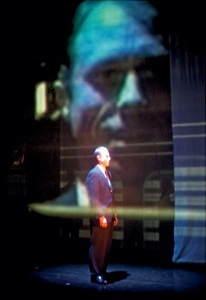I gave a paper at the Royal Central School of Speech and Drama yesterday. Kim Solga is a visiting fellow there and she has a longstanding interest in naturalism, particularly a very interesting project of engaging with but complicating the political critiques of naturalism as a contemporary practice. She's also very interested, as am I, in Katie Mitchell's work which we both see as a contemporary avant-garde naturalist theatre practice. We discussed and decided to make her research seminar there a double-header, with Kim giving a talk and I giving a response.
The particular issues that Kim was interested in are work and labour, and the precariousness (or precarity as people are currently saying) of that labour. She also drew my attention to Jonathan Crary's terrific recent book, 24/7, which takes as its starting point capitalism's constant encroachments on sleep as a kind of last bastion of corporeal resistance to the round-the-clock creation of profit.
Under the joint title 'Precarious Naturalism', our papers were interestingly complementary. Kim gave a rich and nuanced paper looking at moments in Katie Mitchell's work that disrupt time, which resist the accelerating onrushing conversion of time into nothing more than an opportunity for consumption.
My paper looks at the contradictory and paradoxical relationship between Naturalism and precarity. On one hand, Naturalism pays close attention to ordinary people; not tragic heroes, not exceptional or high-born people but ordinary people with their flaws and weaknesses; we are given opportunities to pay attention to them, to feel concdern for them, to feel the weight of that individual life. In addition, Naturalism tries to bring out the individual human heing with real vigour, stripped of the generalisations of classicism or romanticism and the codified gestural languages of melodrama, revealed in its actual particularity. On the othe, it breaks down the boundary between human and animal (the Naturalist human is 'just' and 'no better than' an animal) and between humans and machines (human beings are predictable, their operations finite, their behaviour in principle reducible to a number of organic algorithms). They are also half-living half-dead, constituted by social and biological forces and principles that are not themselves alive.
I find a similar ambivalence in Katie Mitchell's work which both uses technology as a means of scrutinizing the ordinary and everyday but also offers a vision of the human being reduced and marginalisaed by the machine.
I then considered some debates about the status of looking and images. Jonathan Crary's much earlier book Techniques of the Observer suggested that the early nineteenth century saw a dramatic shift in the meaning and experience of looking. Images now became a kind of monetized economy; images began to circulate, stripped of their referents, distributed and exchanged across the world. Photography was a symptom, not a cause of that. I ask if Naturalism might be simply part of that. I conclude not, but think there is some ambivalence there.
Ultimately, I suggest, it's the comtradictions in Naturalism that are the source of what makes it a valuable political resource. It doesn't seamlessly duplicate the world but subjects it to contradictory scrutiny (fact and value, description and prescription) that interrupts the continuing encroachment of capitalism on time and the endless conversion of experience into commodity images.



![photo[1].jpg](https://images.squarespace-cdn.com/content/v1/513c543ce4b0abff73bc0a82/1362919072201-PZO854G4SEB794DVOEI8/photo%5B1%5D.jpg)
